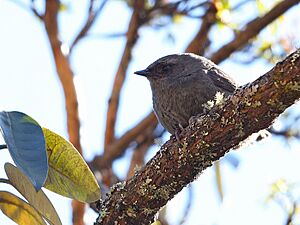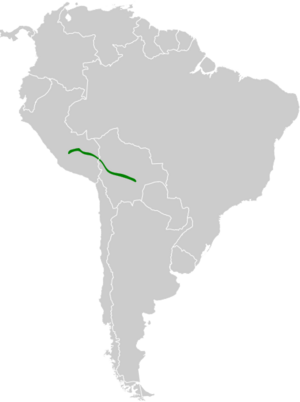Puna tapaculo facts for kids
Quick facts for kids Puna tapaculo |
|
|---|---|
 |
|
| Conservation status | |
| Scientific classification | |
| Genus: |
Scytalopus
|
| Species: |
simonsi
|
 |
|
The puna tapaculo (Scytalopus simonsi) is a small bird. It belongs to the Rhinocryptidae family, which are often called tapaculos. You can find this bird in the countries of Bolivia and Peru.
Contents
About the Puna Tapaculo
How the Puna Tapaculo Got Its Name
The puna tapaculo was first described as its own species in 1917. For a while, scientists thought it was the same as another bird, Tschudi's tapaculo. Later, they thought it was a subspecies of the Magellanic tapaculo.
However, a study in 1997 looked closely at the bird's calls. They found that its songs were very different. Because of these unique sounds, it was then recognized as a separate species. The bird's English name honors Perry O. Simons, an American scientist who collected specimens.
What Does the Puna Tapaculo Look Like?
The puna tapaculo is a small bird, about 10 to 12 centimeters (4 to 5 inches) long. It weighs around 15.7 to 20 grams (about half an ounce).
Adult males usually have gray feathers on their upper body. Sometimes, their neck and back might have a brownish tint. They have a thin, light-colored stripe above their eye, called a supercilium. Their throat and chest are also gray. The lower back, sides, and belly can be a cinnamon or olive-buff color. These parts often have dark stripes.
Adult females look similar to males, especially those with brownish feathers. Young puna tapaculos are generally lighter in color. They have more brown on their upper parts. Their entire underside has stripes.
Where the Puna Tapaculo Lives
The puna tapaculo lives on the eastern side of the Andes mountains. You can find it at high elevations, from about 2,900 to 4,300 meters (9,500 to 14,100 feet) above sea level.
Its home stretches from the Cordillera Vilcanota in Peru's Department of Cuzco. It goes southeast into Bolivia's Cochabamba Department. This bird likes to live in "elfin forests." These are small, dense forests found at the edge of the tree line. Above the tree line, it lives among small shrubs and trees in grassy areas. It can also be found in special woodlands filled with Polylepis trees.
Puna Tapaculo Behavior
What the Puna Tapaculo Eats
Scientists do not know much about what the puna tapaculo eats every day. However, it is likely that this bird mainly eats insects. It might also eat some seeds.
Reproduction and Life Cycle
We also do not know much about how the puna tapaculo raises its young. Only one nest has been found and described. This nest was shaped like a cup and lined with grass. It was placed at the end of a burrow, which was about 1 meter (3 feet) deep.
The nest had a loose dome of woven grass over it. Inside, there were two eggs. After the eggs hatched, both the mother and father birds helped to feed the baby birds in the nest.
What Sounds Does the Puna Tapaculo Make?
The song of the puna tapaculo has been described as a series of churred phrases that go down in pitch. It sounds like "tcherr tcherr tcherr tcherr ...." [1].
One of its calls is described as a descending whinny. It sounds like "djee-ee-ee-eer" [2].
Conservation Status
The IUCN (International Union for Conservation of Nature) has looked at the puna tapaculo. They have assessed it as a species of "Least Concern." This means it is not currently considered to be in danger of disappearing.
Even though it lives in a specific area and we do not know exactly how many there are, human activities do not seem to affect the puna tapaculo much right now.


